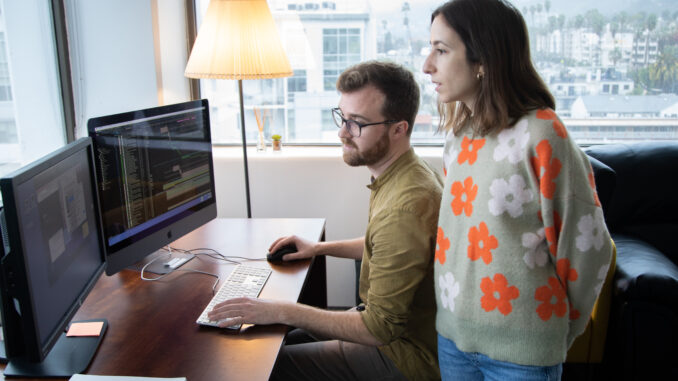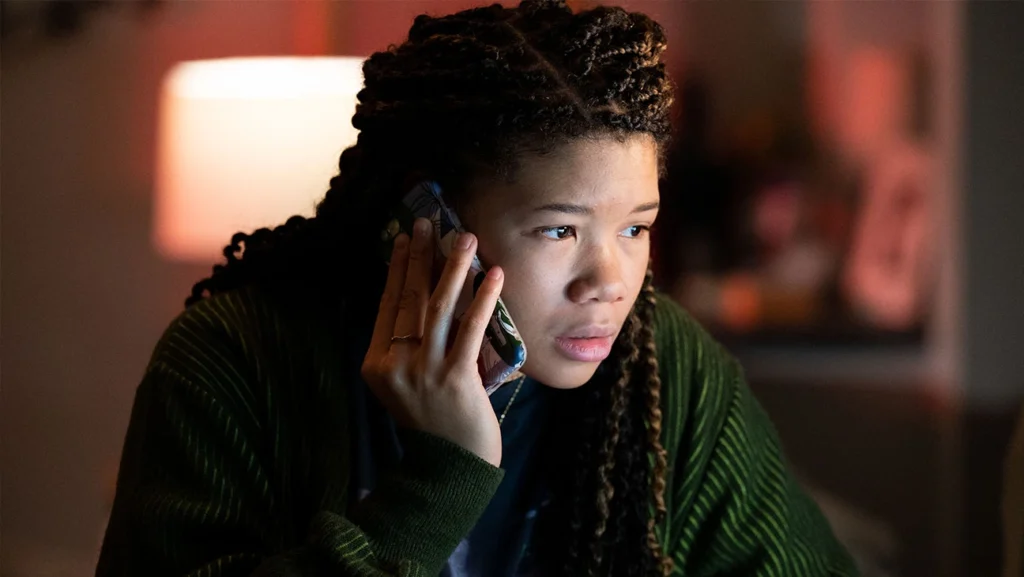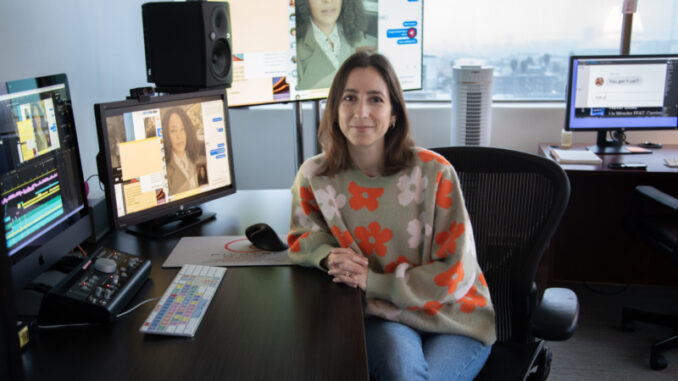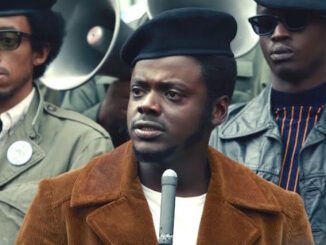
By Peter Tonguette
Sometimes it seems as though mysteries, thrillers, and crime movies of all sorts are stuck in the past. When we watch contemporary movies about unsolved crimes, the protagonists all too seldom avail themselves of the internet, social media, or smartphone technology.
Filmmakers Will Merrick and Nick Johnson have set themselves the task of dragging the thriller form into the twenty-first century.
Merrick and Johnson wrote and directed the new thriller “Missing,” starring Storm Reid as a teenager named June whose mother, Grace (Nia Long), becomes the subject of an intensive missing-person investigation when she disappears amid a seemingly uneventful vacation in South America. While the authorities investigate in their usual plodding manner, the always-plugged-in June chats, searches, and hacks in search of clues. “Missing” was released earlier this year from Sony Pictures Releasing and is available on multiple streaming platforms.
In telling the story, Merrick and Johnson restrict the on-screen action to what June sees (and does) on her computer screen; the audience perceives only what can be perceived on June’s screen. Consequently, much of the film consists of search windows, chat boxes, assorted websites, webcams, and Facetime exchanges. When we see June, it is usually through the camera on her own computer.
To help create the very online universe of “Missing,” Merrick and Johnson — who themselves edited a similar “screenlife” film, 2018’s “Searching,” directed by Aneesh Chaganty, to which “Missing” is a sort-of sequel — turned to picture editors Arielle Zakowski and Austin Keeling.
Prior to the commencement of filming, the post-production partners worked in Adobe Premiere to create an elaborate pre-visualization that included temporary graphics and video elements that was later supplanted by finished elements and footage.
“In a sense, they were animating the movie as we edited, literally creating the shots as we went,” Merrick and Johnson said of the editors. “They had to production design the desktop with folders and windows, they had to act out major character beats with mouse movements, and, meticulously timed, they had to write texts and comments, some of which made it into the final film. . . . It was invaluable, especially as first-time directors, being able to always trust their storytelling instincts.”
CineMontage spoke with Zakowski, Keeling, and sound designer and supervising sound editor P.K. Hooker about one of the most intriguing and involving new releases of the past few months.
CineMontage: Is “Missing” pretty much done in the same format as “Searching”?
Arielle Zakowski: It’s the same idea as far as all taking place on screens and various interpretations of screens. . . . With this one, I think we are all interested in pushing the boundaries a little bit more: What if we have an 18-year-old girl who’s really good at using the computer? What would that look like, and how does that change everything, from what’s on her desktop background and what folders she has up to how does her mouse move around the screen?

CineMontage: Since your palette is limited, how did you work out the pacing and rhythm? How did you know when to cut to what on the screen?
Zakowski: It definitely was challenging a lot of times. In some ways, we had almost infinite choices. Rather than just being locked into what was shot, we could, at any moment, look at any part of the screen or have whoever is using the computer go do anything. I come from a commercial and documentary background, and in a lot of ways, editing [“Missing”] it reminded me of editing a documentary.
Austin Keeling: We got to essentially build performance through the mouse and through the way the camera was covering the scenes. Sometimes, we wouldn’t have any footage at all. The way we animated the different assets and built the scene really informs the audience of what June, or any character, is going through in that moment.
CineMontage: What was the process of constructing the movie?
Zakowski: Austin and I both started working on this film as editors probably six months before production even began, which is, obviously, super-unusual for editors. . . . We started with a completely blank hard drive, a completely blank timeline, and essentially just started building out a pre-vis edit from nothing. We would take screenshots of different apps and assets on our own computers and bring them into Photoshop to modify them as needed. Then, using our own voices and the team’s voices, a temp voiceover for all the lines. The directors would send us still images for all the characters. . . . There’s a party sequence, and Austin and I spent a couple of hours one day just ideating: “OK, what are different ways we could show a party on screens?” Then we would go film rough temp versions of it in our rooms and edit it in. That ended up becoming a real guide for the team when they did shoot.
Keeling: We both came to this with a lot of fear and anxiety about how to accomplish all of this technical wizardry. It was really amazing how, as soon as we had kind of gotten into the flow of things, the technical stuff did fall away, and it became second nature of telling a story.
Zakowski: Once production was happening, it turned into a little bit more of a conventional editing process. We would get the dailies every day. We had our previs edit and would essentially slowly be swapping out the temps with that footage. By the time the shoot was over, we had a working version of the film, with the footage in there, based on our pre-vis edit. . . . Certainly, a tremendous amount changed from what the pre-vis was to what the final film ended up being, as with any film.

CineMontage: When we see the computer screen, are we supposed to be seeing it through the eyes of June as she sees the screen? What is the camera’s perspective supposed to be?
Keeling: There are times where the sort of screen camera is reflecting what June is looking at and how she’s reacting to things, with little zooms when she’s recognizing things and finding facts. I do think overall we were just using the screen camera as a normal cinematic tool and covering [the film] in close-up and slow pans and slow zooms — definitely more outside of June’s perspective.
CineMontage: How did you finalize the graphics — all the screens, text, searching, and so on — in the film?
Keeling: Until we locked, we were mostly using absolute temp graphics that we were just taking screenshots of and altering. . . . Eventually, our team and an external graphics team combined and we recreated every single one of these assets in [Adobe] Illustrator files. Nothing you see in the final movie is screen-recorded, nothing is in-shot. It’s all been created purposely for this film. That allowed us to have a level of control over everything.
Zakowski: One of the main reasons for building everything in Illustrator is so that we can punch in endlessly and get as close to any part of the screen as we need to and it will still look super-crisp and clean.
CineMontage: P.K., what interested you about designing the sound world of the film?
P.K. Hooker: It was somewhat of an unconventional format. Our lead character is never actually seen. She’s ostensibly sitting behind the audience, using her computer, so there’s a lot of off-screen activity. There’s a deceptively large amount of sound design going in — just practical stuff, like things falling and movements and stuff like that, which aren’t really connected to any living person. I had to be really connected to the Foley process, more than usual. . . . Even just the mouse clicks and the trackpad. What does a mouse click sound like when it’s defeated and given up? What does it sound like when it’s excited and onto something? It seems like a silly thing, but this is a movie where it’s really important.
[On the set], if someone was on their iPhone, they didn’t record it with their phone, so all the audio was high-fidelity. It’s always easier to trash it than it is to try to un-trash it. For Storm’s character, for the most part, [her audio] isn’t really that processed because most of the time we’re with her. She’s in the room. All of her mouse clicks, all of her voice, is kind of with us. For the other characters, we did some panning across the screen, from time to time, and a lot of processing just to make them sound like they were coming through on one of those devices.
CineMontage: Austin and Arielle, I was struck by the fact that you have to justify everything we see in the film as something that could be seen on the computer. For example, the TV news clips about June’s mother’s disappearance are seen by June on social media.
Keeling: We had so many conversations: “What news outlets would June actually be using?” That’s where TikTok and Snapchat and things like that come in.
Zakowski: Part of the fun for the audience is waiting to see just how we fit everything into some sort of screen context: “How are they going to tell this part of the story this way?” We kept pushing ourselves to find new ways to present the story in a way that was grounded in the story but still was offering new, fun ways to contextualize it all.
CineMontage: What was it like working with Storm Reid’s performance?
Zakowski: She’s a very mature performer in the way that she can convey so much with so little, which, when you’re alone in a Facetime window in the middle of the night, is what you would be doing. We had a ton to work with from her — quite exceptional.
CineMontage: Have you found that audiences have gotten invested in the movie?
Keeling: It was crazy how we would go into a test screening sure that x, y, and z would not be working, and then the audience loved those things and had problems with other things. For the most part, it was very surprising and encouraging that most people were able to buy into the shape of this, the “screen” way of presenting this film, without much trouble. At the very beginning of the film, it’s sort of like you’re getting used to it, but the way that the movie lulls you in has really helped audiences to sort of forget the gimmick and just let it be a film.






